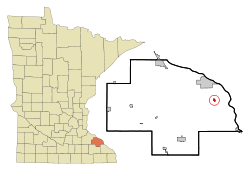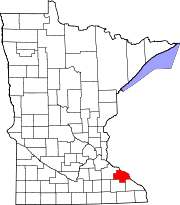Kellogg, Minnesota
Kellogg | |
|---|---|
 US-61 runs by | |
 Location of Kellogg, Minnesota | |
| Coordinates: 44°18′25″N 91°59′56″W / 44.30694°N 91.99889°W | |
| Country | United States |
| State | Minnesota |
| County | Wabasha |
| Area | |
| • Total | 0.32 sq mi (0.82 km2) |
| • Land | 0.31 sq mi (0.80 km2) |
| • Water | 0.01 sq mi (0.01 km2) |
| Elevation | 702 ft (214 m) |
| Population (2020) | |
| • Total | 415 |
| • Density | 1,338.71/sq mi (517.66/km2) |
| Time zone | UTC-6 (Central (CST)) |
| • Summer (DST) | UTC-5 (CDT) |
| ZIP code | 55945 |
| Area code | 507 |
| FIPS code | 27-32642[2] |
| GNIS feature ID | 0646073[3] |
| Website | www |
Kellogg is a city in Wabasha County, Minnesota, along the Zumbro River. The population was 456 at the 2010 census.[4]
History
[edit]Kellogg was laid out in 1870, and named for a railroad sign maker:)[5] A post office has been in operation at Kellogg since 1872.[6] Kellogg was incorporated in 1877.[5]
Geography
[edit]According to the United States Census Bureau, the city has a total area of 0.31 square miles (0.80 km2); 0.30 square miles (0.78 km2) is land and 0.01 square miles (0.03 km2) is water.[7]
U.S. Route 61 and Minnesota State Highway 42 are two of the main routes in the community.
Demographics
[edit]| Census | Pop. | Note | %± |
|---|---|---|---|
| 1880 | 221 | — | |
| 1900 | 228 | — | |
| 1910 | 372 | 63.2% | |
| 1920 | 370 | −0.5% | |
| 1930 | 409 | 10.5% | |
| 1940 | 403 | −1.5% | |
| 1950 | 409 | 1.5% | |
| 1960 | 446 | 9.0% | |
| 1970 | 403 | −9.6% | |
| 1980 | 440 | 9.2% | |
| 1990 | 423 | −3.9% | |
| 2000 | 439 | 3.8% | |
| 2010 | 456 | 3.9% | |
| 2020 | 415 | −9.0% | |
| U.S. Decennial Census[8] | |||
As of 2000 the median income for a household in the city was $37,885, and the median income for a family was $40,515. Males had a median income of $28,125 versus $22,885 for females. The per capita income for the city was $16,216. About 6.5% of families and 14.0% of the population were below the poverty line, including 18.8% of those under age 18 and 9.5% of those age 65 or over.
2010 census
[edit]As of the census[9] of 2010, there were 456 people, 200 households, and 129 families residing in the city. The population density was 1,520.0 inhabitants per square mile (586.9/km2). There were 208 housing units at an average density of 693.3 per square mile (267.7/km2). The racial makeup of the city was 99.1% White, 0.7% Asian, and 0.2% from two or more races. Hispanic or Latino of any race were 0.2% of the population.
There were 200 households, of which 28.5% had children under the age of 18 living with them, 50.5% were married couples living together, 8.5% had a female householder with no husband present, 5.5% had a male householder with no wife present, and 35.5% were non-families. 27.0% of all households were made up of individuals, and 14% had someone living alone who was 65 years of age or older. The average household size was 2.28 and the average family size was 2.78.
The median age in the city was 41.5 years. 21.7% of residents were under the age of 18; 5.6% were between the ages of 18 and 24; 28.7% were from 25 to 44; 26.6% were from 45 to 64; and 17.5% were 65 years of age or older. The gender makeup of the city was 49.6% male and 50.4% female.
Economy
[edit]The Mississippi River Lock and Dam No. 4 is located near Kellogg.
Transportation
[edit]Amtrak’s Empire Builder, which operates between Seattle/Portland and Chicago, passes through the town on BNSF tracks, but makes no stop. The nearest station is located in Winona, 27 miles (43 km) to the southeast.
Residents
[edit]- Katherine Hancock Goode, state legislator in Illinois
References
[edit]- ^ "2020 U.S. Gazetteer Files". United States Census Bureau. Retrieved July 24, 2022.
- ^ "U.S. Census website". United States Census Bureau. Retrieved January 31, 2008.
- ^ "US Board on Geographic Names". United States Geological Survey. October 25, 2007. Retrieved January 31, 2008.
- ^ "2010 Census Redistricting Data (Public Law 94-171) Summary File". American FactFinder. United States Census Bureau. Retrieved April 27, 2011.[dead link]
- ^ a b Upham, Warren (1920). Minnesota Geographic Names: Their Origin and Historic Significance. Minnesota Historical Society. p. 557.
- ^ "Wabasha County". Jim Forte Postal History. Retrieved August 10, 2015.
- ^ "US Gazetteer files 2010". United States Census Bureau. Archived from the original on July 2, 2012. Retrieved November 13, 2012.
- ^ "Census of Population and Housing". Census.gov. Retrieved June 4, 2015.
- ^ "U.S. Census website". United States Census Bureau. Retrieved November 13, 2012.

